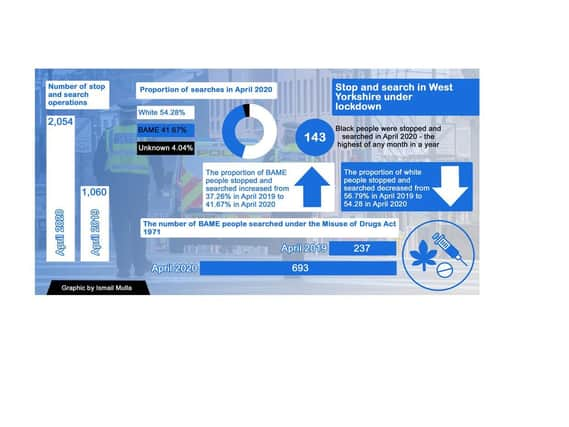Why stop and search of minorities by West Yorkshire Police increased during lockdown


Stop and search operations carried out by the force nearly doubled in April 2020 compared to the same month last year.
In April 2019, there were 1,060 stop and search operations conducted by West Yorkshire Police. The figure rose to 2,054 this year.
Advertisement
Hide AdAdvertisement
Hide AdWest Yorkshire Police says the increase in the number of stop and search operations carried out could be attributed to coronavirus restrictions
A spokesman said: “Under Health Protection (Coronavirus Restrictions) legislation, our policing style and approach has been focused on interacting, engaging with and questioning the behaviour of those who were in public places.
“We believe the increase in the figure for April 2020 compared to April 2019 can be attributed to this, and the same trend is also noticeable for May this year compared to last year.”
West Yorkshire Police attributed part of the increase, 11 per cent of the total figure for April 2020, to the number of searches carried out under Operation Jemlock – the force’s dedicated response to knife crime.
Advertisement
Hide AdAdvertisement
Hide AdThe spokesman added: “The majority of people remained at home during the initial lockdown period, making it much more difficult for those committing crime to travel without detection.
“Using additional dedicated resources, demand hotspot locations were patrolled, resulting in more proactivity and use of stop and search as well as other forms of enforcement to reduce crime.”
The proportion of people from black, Asian and minority ethnic (BAME) backgrounds, as identified by the Police, being stopped and searched increased from 37.26 per cent in April 2019 to 41.67 per cent in April 2020.
Further in-depth analysis shows that stop and search operations involving Asians increased from 26.51 per cent to 33.4 per cent.
Advertisement
Hide AdAdvertisement
Hide AdWest Yorkshire Police said: “Figures show people from BAME backgrounds are generally overrepresented in stop and search figures nationally.
“Police forces and senior officers continue to examine the disparity in stop and search data and work directly with local communities to listen to their concerns.”
The Equality and Human Rights Commission (EHRC) said these stop and search figures were “concerning”.
It added: “Stop and search powers must be used in an intelligence-led way. Anything else threatens relationships between police and the communities they serve.
Advertisement
Hide AdAdvertisement
Hide Ad“We are also concerned by the Government’s decision in 2019 to remove safeguards that limit the use of stop and search powers without suspicion - despite the Home Office’s own assessment indicating this could have a discriminatory impact.
“We have continuously called on police forces, the Home Office and Police and Crime Commissioners to not only retain, but also build on protections designed to promote fair and equal policing and ensure that they engage effectively with our diverse communities.”
West Yorkshire Police says stop and search powers are subject to “robust scrutiny”. It also added that it was “one of the first forces” to join the Home Office Best Use of Stop and Search Scheme in 2015.
“It is our policy to record every stop and search on body worn cameras to further increase accountability and we also regularly speak with independent advisory groups and independent scrutiny panels to see how we can improve the process,” West Yorkshire Police said.
Advertisement
Hide AdAdvertisement
Hide AdThe legislation used most by police to stop those from a BAME background was section 23 of the Misuse of Drugs Act 1971. This is when a person is suspected of being in possession of drugs.
In April 2019, 237 people classed as BAME were searched under the act. That figure rose to 693 in April of this year.
The spokesman for West Yorkshire Police said: “Suspected drugs offences were the reason for the search to be carried out in 67.1 per cent of the cases.
“Drugs misuse is present across all levels of society and is not confined to any particular community.”
Analysis
Advertisement
Hide AdAdvertisement
Hide AdThe data shows that during a month, when the Government imposed lockdown measures were in place, stop and searches almost doubled from the same period the previous year.
While 56.79 per cent of those who were stopped and searched in April 2019 were classed as white by West Yorkshire Police, that percentage dropped to 54.28 in 2020.
However, fortunes for the BAME community were different. Overall, there was an increase from 37.26 per cent to 41.67 per cent.
When you break this figure down, the proportion of stop and search operations involving those identified as black by the police force dropped when the two months were compared.
Advertisement
Hide AdAdvertisement
Hide AdIn April 2019, 10.28 per cent were classified as black by the force, while this year it was down to 6.96 per cent.
April 2020 still saw the most number of black people, 143, stopped and searched, compared to any month over the past year.
The real increase comes as a result of stop and search operations involving Asians with the percentage going up from 26.51 to 33.40.
There is an acknowledgement from the force that ethnic minorities are overrepresented in stop and search operations and these figures reinforce that this is still an issue.
But as West Yorkshire Police points out it’s not just an issue affecting them but police forces up and down the country.
Comment Guidelines
National World encourages reader discussion on our stories. User feedback, insights and back-and-forth exchanges add a rich layer of context to reporting. Please review our Community Guidelines before commenting.